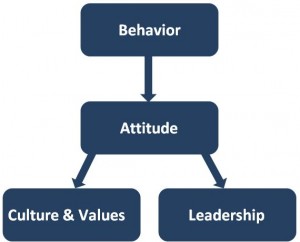Most of us are keenly aware of all the legislation regarding regulations, rules, codes and standards for HSE matters in industry. (And, in case you have forgotten check out our recent blog posts!) These legislative initiatives are important and we couldn’t operate successfully without them.
The Problem with People
The challenge in any organization, particularly with HSE compliance, is that we are dealing with a most unpredictable and changeable asset – people. They often don’t heed rules and regulations. People are emotional, have differing needs, and make mistakes from time to time. We often have injuries and fatalities as well as a high turnover of personnel even after we have trained them and shown them all the rules.
We hear employers and supervisors complaining “Why don’t they listen and obey the rules?” or “How can we change their behavior for the better?” or “Maybe we need more Safety Officers (police) to enforce the rules.”
Rather than focus attention directly on the behaviors alone, let’s try to get to the root cause of why people behave the way they do in the workplace.
What Drives Behavior?
I think we can all agree that we want positive behaviors from our workers. That could mean things like employing workers who:
- care about their work
- care about their co-workers
- care about the company
There are many ways to change or have an influence on our peoples’ behaviors.
One popular way is to observe behavior, make comments to the worker, suggest changes and reinforce the new behavior until it becomes the new and improved way of doing things. There has been some success in this area; however I believe that we need to get to the root cause of behavior in order to make effective and lasting changes.
Take a look at the “equation” below:
In the workplace, when we see people exhibiting very good or bad behavior we often say that they have a good or a bad attitude. It would thus seem that behavior is a manifestation of attitude. Therefore, in order to have a positive effect on peoples’ behaviors we must first have a positive effect on their attitudes.
How does one accomplish this? Remember we are dealing with people in the workplace. So, let’s start at the root of the equation.
Workplace Culture and Values
If we build and maintain a positive culture of operation and safety and live by the culture we have built we will see some positive results. There are three basic types of workplace culture:
- Dependent – we do as we are told and follow the rules exactly as they are laid out. If there isn’t a rule for a particular situation then we really don’t know what to do.
- Independent – we start to think for ourselves and look for ways to do things and protect ourselves even when there are no rules in place to guide us. We don’t worry about anybody else.
- Interdependent – we not only look after ourselves but we also look out for the people around us. We often have an unwritten deal. I will help you to be safe and efficient and you will help me to be safe and efficient.
There are many tools and ways to build an interdependent culture within organizations.
In order to address culture we must look at values. We can start with the question “Why is safety important to you?”. It doesn’t take long for the answer to become clear and unanimous and it really has little to do with the rules or what the boss has told us. It comes down to family. We stay safe because there are loved ones who need us to come home in good health.
Let’s blend the culture and value into one statement. “I will help you to stay safe; you help me to stay safe so we can go home to the people who love and need us”. That is an excellent example of using personal values to promote and maintain an interdependent culture.
Leadership
Now let’s look at the third factor in the equation – leadership. There can be a big difference between management and leadership. Ideally they are one in the same but often they are not. A good leader will understand and continually demonstrate:
- strong emotional intelligence
- the ability to empower and motivate teams
- empathy
- a sense of justice
- skill in changing leadership styles instantly depending upon the situation at hand
- a caring for the growth and well-being of the individual team members
- a strong loyalty to the team
- a firm and clear understanding of the values and culture of the organization
Good leadership starts with the senior management team and cascades down to all the supervisors and managers within the organization. It becomes an integral component in the organization’s culture.
If we have effective leadership who can promote the culture and values mentioned in the equation using all the tools we have described then we will see positive attitudes amongst all workers at all levels within the group. That will lead to positive behaviors in productivity, safety and ultimately profitability.
This means that workers will:
- care more for their jobs and their responsibilities
- become more loyal to their leaders and their company
- feel a stronger sense of ownership
- become more interdependent as they look out for one other
- be safer and more productive and encourage that attitude with others
And, that companies will have:
- a more loyal and motivated workforce who take pride in their work and reputation
- greater employee retention
- a safer workplace
- higher productivity
An organization which has a productive and profitable operation and achieves results in a safe and efficient manner has attained Operational Excellence.
Thanks for reading. Keep safe. Be healthy. Respect your environment.
We hope that you will bookmark the blog, share it with your colleagues and visit the blog frequently because you find it informative and helpful. We value your feedback and suggestions for future topics.
Please enter your email in the box at the top of the post and subscribe to our blog HSE Asia - our weekly blog will be emailed directly to you.
Next Week’s Blog Topic: Build Your Own HSE Legal Register with This Simple 5-Step Process
Photo Credits: Excellent image courtesy of Stuart Miles at freerange.com
Granthasa proven track record ofguidingorganizationsto continuouslydevelop leadership skills,improvesafety culture,andpromotepersonal values.He works with companies to design,facilitate and coachcustomized development of Interdependent Safety Cultureswithin organizationsas well asthe essential Leadership skillsto achieve “Operational Excellence”.
Grant can be contacted directly via email at gkelly@redlogenv.com.
- The Road to HSE Operational Excellence - February 1, 2016


I liked it. Behavioral control is everything.
Khaled, thanks for your comment. I definitely agree. Grant is an expert is this issue and did a good job explaining it very clearly in the blog post.
Good article. To achieve HSE operational excellence, we need to focus on safety hardware – machine & equipment, software – management system and people’s mindset equally.
Sharon,
Thank you so much for your great comment. I agree with you and have seen many instances where organizations are satisfied with their HSE MS, policies, procedures and equipment. The attitudes and behaviours of people are just as important in achieving a truly safe and productive culture in the workplace. The leaders are the drivers behind this.
Grant Kelly